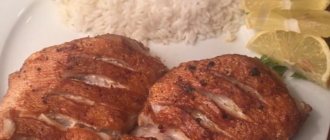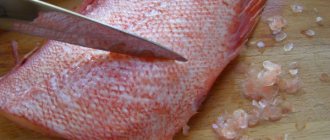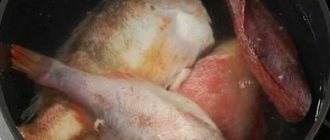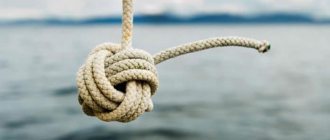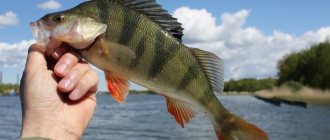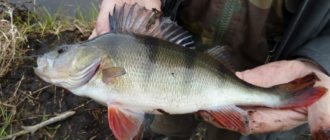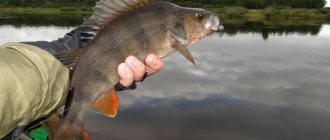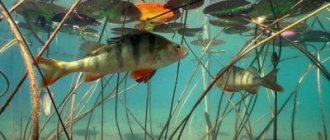Appearance
Pacific species of perch are found mainly in coastal waters, while Atlantic species are found in bottom and deep-sea waters.
The color of sea bass is varied. The deeper the habitat, the brighter and redder it is. It's lighter in shallow water.
The mouth is large. The main weapon is the spiny rays on the dorsal, pectoral and anal fins, between which poisonous glands lurk. Their injections are very painful, the wound becomes inflamed, and the treatment takes a long time. For this, the perch received another name - “spiny-finned”.
In all the photos on the Internet, the perches look bug-eyed. This is not a vice, but a consequence of lifestyle. The deep-sea inhabitant is forced to adapt to the eternal twilight and, being a predator, also hunt in such conditions. Hence his lens-like eyes.
Dimensions
Representatives of different Sebastes species differ not only in color, but also in size. Some are small, barely reaching a length of 20 cm, others exceed 1 meter.
The largest individuals caught in Russia live in the Bering Sea. They grow more than one meter in length and weigh over 20 kg.
Reproduction
All sea bass are viviparous fish.
The eggs are not fertilized immediately, but some time after the male and female have mated. Embryos develop quickly. A large female can sweep out about 2 million larvae 5–6 mm long.
At first, transparent and inconspicuous fry adhere to the upper layers. As they grow up, they gradually descend lower into the bottom layers.
Juveniles live in areas where they were carried by the current in the first year of life, without making long movements. Significant migrations occur only upon reaching sexual maturity.
Features of the body of perches
Deep-sea fish withstand enormous ocean pressure. The swim bladder, into which gas is constantly pumped, helps them adapt to pressure.
To float, the gas must be released from the bubble. But the speed of release is slower than the speed of ascent (retrieving gear). With a sharp drop in pressure, decompression sickness occurs. Therefore, in perches lifted by a trawl into the upper layers, the eyes bulge, the stomach turns outward, and gas bubbles swell under the fins.
Red sea bass
Sea bass belongs to the deep-dwelling species of bony fish of the scorpionfish family. They have an unusual bright color of pink, orange or red in fish living in the upper layer and spotted-striped in deep-dwelling representatives. The eyes are large, saucer-shaped and adapted for bottom existence. Fishing for red sea bass is carried out using trawls and nets, longlines at a depth of 400-500 m, where the fish mainly live.
Golden sea bass (red) - Sebastes marinus
The golden sea bass has a laterally flattened body, bulging eyes, and a protruding lower jaw. The color is bright red - which is why it is called “red fish”. The belly is pink, all fins are orange-red and equipped with poisonous spines
Found in the northern part of the Atlantic from the coast of Norway to the Barents Sea.
In Russia they fish in the Barents and Norwegian seas, in the Far East.
Red predators live and hunt in small flocks at great depths, mainly on rocky soil covered with shells and silt. The largest concentrations of perch are observed when the water temperature is not lower than 2–3°C. They unite in large schools in the open sea when they go to spawn.
Appearance and varieties
Sea perches have a great external resemblance to freshwater perches: the body is laterally compressed, there are 2 dorsal fins, there are sharp spines on the fins, and some species even have vertical dark stripes. But the internal structure is so different that scientists classified sea bass as a separate family - scorpionfish. The peculiarity is that the spines on the fins are glands that produce a toxic substance. If the thorn stings, a very painful inflammation begins.
The size of sea bass and the color of their body are different depending on the species and habitat. They can be red, orange, white, black and multi-colored. Some representatives of sea bass easily fit in the palm of your hand, while others reach a length of up to a meter or more. The mass of fish ranges from several grams to several tens of kilograms. Let's consider only those that are of great interest to anglers:
- Stone;
- White;
- Blue;
- Klyuvach;
- Golden.
Rock Perch
White perch
Blue Perch
Golden perch
Beaked perch
Rockfish have a white body with numerous black spots. The usual body length is no more than 10 centimeters, but large specimens up to 3 meters in length are very rarely found, and their weight can exceed 400 kilograms. White bass have a white body with faint brown stripes and grow up to 12 centimeters. Blue sea bass has a blue tint and is also not very large - a maximum of 17 centimeters.
Beakfish and golden sea bass are very similar and can easily be confused with each other. They have a red body, and the abdominal part has a white tint. Their main difference is the growth on the lower jaw. In the beaked fish it is large, but in the golden fish it is very difficult to see. The beak reaches a length of 58 centimeters, a maximum weight of 2 kilograms and 500 grams. The average length of golden sea bass is 40 centimeters, the maximum is 1 meter, and the maximum weight is 15 kilograms.
Fishing
The taste of the white meat of red fish is highly prized. Of all the fish in the world's oceans, perch is the most susceptible to fishing pressure.
Massive fishing began relatively recently, when bottom trawls began to penetrate to depths of 400-500 meters, where valuable fish mainly live. During the Soviet five-year plans, planned production rates were many times higher than the population, and trawls grossly destroyed underwater corals and sponges.
The number of perches in the Russian northern seas has decreased by at least 10 (!) times over 30 years. This fish becomes a “rarity” every year. Therefore, they are now catching much less, and they deliberately continue to reduce production in order to at least in this way maintain the number of this wonderful fish.
Norwegians, who are more environmentally conscious, carefully guard their mining secrets. There are still some Norwegian regions where, if the weather is favorable, the catch can be over 150 kg. Its price in the country is very high. It is also a subject of sport fishing skill.
Benefit
Golden perch is not only a tasty, but also a healthy fish. It is rich in minerals and vitamins, and contains the amino acid taurine, which is involved in fat metabolism.
Red sea fish is vital for those who have problems with blood vessels and heart - heart attacks, strokes, high cholesterol, arterial hypertension.
The iodine it contains helps normalize the proper functioning of the thyroid gland and endocrine system.
Eating sea bass meat by children protects them from rickets.
The meat remains fresh after being caught for 5-7 days in the refrigerator. But the frozen product does not lose its beneficial qualities.
Characteristics of sea bass and its chemical composition
In general, the concept of “sea bass” applies not to one type of fish, but to several at once. They live in tropical and subtropical latitudes; today people are trying to breed them in an artificial environment. Unfortunately, research has shown that individuals raised in synthetically created conditions do not have the same positive characteristics as “wild” fish. Dishes made from them are not as tasty and healthy, so they are rarely part of a healthy diet.
Tip: Cleaning sea bass can be quite challenging if you don't know how to do it correctly. There are two main recommendations to remember. First, it is better to cut off the thorns at the very beginning, otherwise there is a risk of puncturing the skin and developing irritation. Secondly, it is very difficult to remove scales from a perch; it is better to simply cut it off along with the skin, or at least put the fish in boiling water for a couple of minutes.
Externally, sea bass is not very different from the river representative. It is distinguished by its specific red skin color, bulging eyes and poisonous spikes of impressive size. Such differences are due to the special habitat of deep-sea fish. The internal structure of individuals varies greatly, which must be taken into account when gutting and cutting them. Consumers are accustomed to the small size of sea bass, but representatives of the species can grow up to a meter.
To understand what its benefits and harms are for the body, you need to study the composition of the product:
- The product is rich in proteins, low in fat and virtually no carbohydrates. Combined with its low calorie content - only 79 units per 100 g of product - this makes sea bass an indispensable component of dietary and sports nutrition.
- The meat of individuals contains a lot of vitamins B6 and B12. The latter is necessary for the synthesis of hemoglobin and protein compounds, without which the transport of oxygen throughout the body is impossible.
- In addition, sea bass meat contains vitamins A, PP, D and other representatives of group B. They are necessary to maintain metabolic processes and prevent the development of deficiency conditions.
- Like any fish, sea perch is rich in minerals. In particular, these are iron and selenium. Iron is necessary to maintain blood composition and the synthesis of energy-producing enzymes. Selenium stimulates metabolism at all levels. The product also contains calcium, potassium, magnesium, phosphorus, copper and zinc.
- Sea bass is also rich in taurine. This is a special sulfur-containing acid that gives the product the properties of a medicine. It stimulates processes in the brain, increasing the activity of its cells. Deficiency of the substance negatively affects the state of the nervous systems and eye health.
- Of course, the product also contains fatty acids. They have a beneficial effect on the composition of the blood, the functioning of blood vessels, heart muscle and brain.
Thanks to this composition, the benefits of sea bass meat for human health are enormous. You just need to figure out how to properly prepare the product to achieve the desired results.
Aleutian sea bass – Sebastes aleutianus
Habitats:
- north Pacific,
- coast of the Kuril Islands,
- California,
- coast of eastern Kamchatka,
- in the Bering Sea, Gulf of Alaska.
It got its name from the Aleutian Islands, where it lives in especially large numbers.
The Aleut looks intimidating even in the photo: along the massive body of a dirty red color there is a clearly defined red stripe. The belly is light and pink. The large head is studded with spikes, and a tubercle sticks out on the lower, forward jaw. There are 3-10 sharp spines around the eyes. Fins with dark edging.
Aleutian perch is a long-lived sea fish. The most authoritative database of animal life expectancy today, AnAge, puts it in second place - 205 years, after the bowhead whale - 211 years.
Old-timers die not from old age, but only from the fact that with prolonged growth and increase in mass, their speed of movement decreases, as a result they cannot catch up with their prey or escape from another large predator.
The age of a fish is determined by the number of rings on its scales.
Types of sea bass
Sea bass is of interest for both fishing and cooking. It is popular due to its excellent taste and is common in water bodies.
Northern sea bass
Representatives of northern sea bass are the largest, and their species is the most numerous. The body is firmly covered with hard scales of reddish shades. The lower part of the body may have dark spots. The danger comes from the poisonous spines on the dorsal fins and head.
They prefer to live individually or in small groups in hard-to-reach places, rocks and algae. The depth of their habitat is relatively shallow - about 300 m. They feed on sea reptiles and other inhabitants of the seabed.
Oriental
The body is about 30 cm, compressed at the sides. The ridges and spines are not developed. Jaw without scales. The tail fin is intact, without a notch. Eastern redfish are brownish-purple in color, becoming lighter towards the abdomen.
It lives mainly in shallows near the coast, hiding in sea grass, and less often in the mouths of reservoirs near the sea.
During daylight hours - in stones and rocks at a shallow depth of about 10 m; in the evening it subsides in algae. Young eastern perch can be found at a decent depth.
Terpug
Terpug is a schooling sea fish, a predator, part of the order of scorpionfish. Fresh fillets have an unusual yellow or green tint. The length of the fish reaches half a meter and weighs 1.5-2 kg, but there are also heavy representatives.
With a similar length, the weight can reach 60 kg. In some greenlings, the dorsal fin is completely solid, while in others it is dissected by a depression.
Aleutian
Aleutian perch looks scary:
- a massive fish with a large head studded with spines;
- the lower part of the eye has 2−10 sharp spines;
- the lower jaw is pushed forward, and there is a symphysial tubercle on it;
- the fin on the back has 13 hard and 13-14 soft rays;
- caudal fin with a notch.
The color of the perch is dirty red with black and gray fuzzy stripes on the head and the entire upper surface, the belly is light, there is a red line on the side, and the fins have a dark edging.
Black Sea
Black Sea perch goes by many other names. The original is spicara, another one is “smardina”, which comes from belonging to the smardinaceae family. He also received nicknames depending on his color and habits - “redfish”, “beaver” or blue perch.
Like previous species, it has a laterally compressed carcass, a solid dorsal fin with 10-12 spines, and an anal fin with three. The predator has many small teeth and even 2 protruding fangs from below. An interesting feature of the representatives is that their mouth extends into a tube. Black Sea perch on average lives up to 4-5, maximum 7 years.
Stonefeather
The laterally flattened body is covered in small scales with teeth. Almost all fins and the body itself have spines:
- the fin on the back has hard and soft rays, about 30 of both in total;
- there are 3 spines on the anal fin, one spine each on the chest and abdomen;
- there are 3 spines on the gills.
Nature has provided that due to the variegated colors, the fish would be difficult to find among algae and stones. The brown body has vertical stripes on the sides, flowing through the tail into the dorsal fin. Because of them, the perch received the nickname “zebra”. The color range can range from blue to dark brown.
The head is decorated with dark red stripes, and the belly is bright blue in places. The fish has many sharp teeth and a large mouth. The size of the perch is about 25 cm; individuals of this species larger than 30 cm are considered giants.
White
Another name is Barramundi. It has a long body 1.5−1.7 m, weighs about 40 kg. When fishing, they usually come across about half a meter long and weighing a little more than 10 kg.
External features of white perch:
- the head is compressed from above;
- the jaw protrudes from below;
- high body;
- small anal fin.
A good catch of young fish can be obtained in late summer - early autumn. Found on the surface and at depth. Prized for its excellent taste.
Black sea
It has an unusual olive-green coloration, sometimes with black spots forming a jagged line on the sides. It is considered the largest of all black perch representatives. Females are always larger than males. It chooses a habitat in calm, quiet water, where it can hide in the thickets and wait for prey.
From mid-spring, it goes to spawn for 4 months, which happens once a year. Males prepare a nest at the bottom, where the female can lay up to 80 thousand eggs, after which the male undertakes to guard them until the fry appear. Black sea bass live a long time - about 23 years.
Baikal
Lives mainly in Chivyrkuisky Bay. The size is average, about 25 cm, rarely found up to 40 cm. The body is cylindrical, the sides are flattened. He received the nickname “humpback” for the hunchback shape of his back. Spawns at a depth of 2 meters. The female lays up to 50 thousand eggs.
deep sea
Deep sea perch is also called Kinky. Lives in deep waters. The fins are equipped with poisonous spines. An injection with them provokes inflammation and threatens severe pain. This fish is colored bright red, may have stripes or spots on its body, and has large bulging eyes.
It reaches one meter in length and weighs about 18 kg. In their “appearance”, red perches are similar to river perches, but they differ greatly in body structure.
Beaked perch (beaked perch) - Sebastes mentella
This species is a descendant of the northern Pacific grouper, which entered the waters of the North Atlantic through the Arctic more than a million years ago.
Beaked perch is a deeper-water and cold-loving fish compared to golden perch; it lives at depths from 300 to a maximum of 1440 m at a bottom temperature of 4–5 ° C.
The name is given for the strongly prominent growth at the tip of the lower jaw.
Habitat:
- Barents and Norwegian seas,
- coasts of Iceland and Greenland,
- California, coastal areas of North America.
Based on the location of distribution and appearance, the beaked fish is divided into Pacific and Atlantic.
The quiet perch has blood-red scales, the length of the fish reaches 55 cm, and the weight is 2.5 kg. Dive depth - 830 m, life expectancy - maximum 105 years.
The Atlantic beaked beak is smaller, never growing more than 50 cm. The scales are dark scarlet. The sizes are approximately the same. Lives longer than its relative.
Habitat
Widely distributed in the North Atlantic Ocean and the Arctic Ocean:
- western part of the Barents Sea until the 35th century. d., off Western Spitsbergen, Greenland Sea, Norwegian Sea, off the coast of northern Norway, around Iceland and the Faroe Islands;
- off the coast of eastern and western Greenland;
- off the east coast of Labrador and Baffin Island;
- Baffin Sea, Irminger Sea, Labrador Sea;
- south along the coast of North America to Cabot Sound and Long Island.
Where is it found?
Sea bass are found everywhere, but they have favorite places. Fishermen know that a good catch can be obtained in Norway. At a depth of 200-300 m you can even find rare red snapper. There are many of them in the Atlantic Ocean and the North Pacific Ocean.
This fish is much more comfortable in cold waters. Sometimes it can be found at a depth of 900 m. The fish migrates in schools in the Norwegian and Arctic Oceans.
Is it grown artificially?
If sea bass is found on the shelves, 90% of it is caught from natural bodies of water. This fish is not artificially grown. The Lavrak species of perch began to sharply decrease its population, so they were forced to adapt it and breed it artificially.
Unnatural living conditions always affect the quality of fish.

